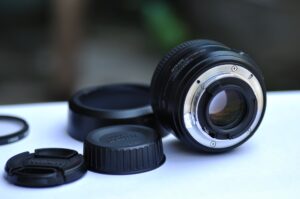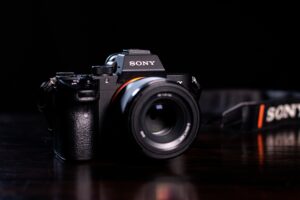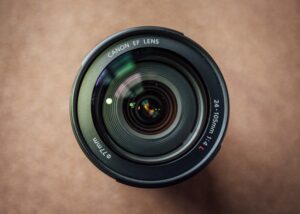How do you clean a camera lens? Through careful and regular maintenance using specific techniques and tools. The health of your lens significantly influences the quality of your photos.
In this guide, we’ll take you through the step-by-step process of lens cleaning, from determining if your lens needs cleaning to selecting the right tools for the job.
With a clean lens, you can ensure every shot is as crisp and clear as intended.
How to Determine if Your Lens Needs Cleaning
Before you reach for those cleaning tools, it’s vital to determine whether your lens genuinely needs a clean. Cleaning too frequently or without cause can risk unnecessary wear.
Here’s how to perform a simple dirt test:
Performing a Dirt Test on Your Lens
- Setting the focus to infinity: This step ensures that any dirt or smudges on the lens will be evident in the test photo.
- Taking a photo of a plain surface: A white wall or a clear blue sky works best for this. The uniformity of the background will make any dirt or blemishes on the lens stand out.
- Examining recent photos for signs of dirt or smudges: Look through your latest images. Are there consistent spots or blotches appearing? If yes, these might be due to dirt on your lens or sensor.
Other signs of a dirty camera lens:
- Flares or ghosting: These can be caused by smudges or fingerprints on the lens.
- Loss of sharpness: A thin layer of dust can impact the clarity of your images.
- Visible particles: Sometimes, the dirt is evident upon a simple visual inspection.
Essential Tools for Cleaning Your Camera Lens
Every photographer, from novices to seasoned professionals, should have a dedicated lens cleaning kit.
Proper maintenance ensures that your gear remains in top shape and continues to deliver high-quality images.
To adequately address every type of dirt or smudge your camera lens may encounter, you’ll need a range of tools.
Four Must-Have Supplies in Your Camera Cleaning Kit
Air Blower
A critical first step in the cleaning process is to use an air blower. This tool ensures you can remove larger particles or dust without making direct contact with the lens.
Benefits:
- Prevents scratching the lens.
- Removes larger particles that could smear if wiped.
Recommended Types:
Opt for a HEPA Blower – it’s dust and moisture-free, ensuring that you don’t introduce new contaminants onto your lens. Fun fact: even NASA approves of it!
Soft-bristled Brushes
Sometimes, stubborn particles cling to your lens. That’s where a soft-bristled brush can be a lifesaver.
Importance:
- Safely dislodges adhered particles.
- Gets into nooks and crannies of the lens barrel.
Specialty Brushes:
The Flat Blower Brush is a hybrid tool that offers the benefits of both a brush and a blower, making it an handy addition of any cleaning kit.
Microfiber Cloth and Camera Lens Wipes
After removing particles, you might still notice smudges or fingerprints. A microfiber cloth or lens wipe is perfect for this final polishing touch.
Benefits:
- Won’t scratch or damage the lens.
- Effectively removes smudges, oils, and fingerprints.
Recommended Types:
A 12×15″ Microfiber Lens Cleaning Cloth provides ample size to clean even larger lenses, ensuring no smudge is left behind.
Cleaning Fluid
For those persistent spots or smudges, sometimes a bit of liquid help is necessary. A cleaning fluid designed specifically for lenses is the way to go.
Benefits:
- Breaks down tougher smudges or residues.
- Evaporates without leaving a residue.
Recommended Types:
Eclipse Cleaner for Sensors & Lenses is a popular choice among photographers. It’s designed to be tough on dirt but gentle on your gear, ensuring your lenses stay spotless and scratch-free.
Armed with these essential tools, you’ll be well on your way to maintaining a pristine camera lens.
By ensuring that each tool is used correctly and at the right time, you can enhance the longevity and performance of your equipment.
And if you’re pondering over the necessity of lens filters or protectors, you might find this article interesting.
Step-by-Step Guide to Cleaning Your Camera Lens
Maintaining a pristine camera lens is about more than having the right tools—it’s also about employing the correct techniques.
Here’s a methodical approach to ensure you clean your lens efficiently and safely, preserving its clarity and integrity.
1. Blowing off the Dust
Before diving deep into cleaning, the initial step is to blow off the superficial dust and debris on your lens. This step ensures that when you wipe or brush, you don’t scratch the lens with larger particles.
Importance of using a dedicated blower:
- Safety: A blower is designed to provide a forceful gust of air without any contaminants.
- Efficiency: It’s more powerful than a breath and targets areas with precision.
Why you shouldn’t blow on the lens directly:
- Moisture: Breathing on your lens introduces moisture, which can smudge or harm the lens coating.
- Contaminants: Our breath can carry tiny particles or bacteria which may be harmful to the lens.
2. Using a Lens Brush
Once the larger particles are off, you can attend to the smaller, more stubborn specks with a brush.
Proper technique and best practices:
- Gentle strokes: Always use gentle, outward strokes starting from the center of the lens.
- Avoiding touch: Ensure your fingers don’t touch the bristles. Oils and dirt from your skin can transfer to the lens.
- Storage: Always cap or store your brush in a clean place to keep it free from contaminants.
3. Applying Camera Lens Cleaner
For stubborn smudges or fingerprints, a lens cleaning fluid can be your best ally.
When and how to use cleaning fluid:
- Spot Cleaning: Only use it when necessary for noticeable spots or smudges.
- Applying to cloth: Instead of applying directly to the lens, put a few drops on a cleaning cloth or tissue. This ensures you use the minimal amount and prevents any potential damage from the liquid seeping into the lens barrel.
- Ensuring you don’t apply directly to the lens: Direct application can risk the fluid seeping into the internals of the lens, leading to damage. Always use a cloth or tissue as a mediator.
4. Final Wipe with a Cloth or Tissue
The last step is to ensure that the lens is completely clean and free of streaks.
Choosing the right cloth or tissue:
- Material: A microfiber cloth is ideal. It’s soft, lint-free, and designed to capture oils and dirt effectively.
- Alternatives: If you don’t have a microfiber cloth, lens tissues can also work. They’re soft and disposable, ensuring each clean is with an uncontaminated tissue.
Ensuring a streak-free finish:
- Direction: Like with the brush, start in the center and work your way outwards. This technique helps move any contaminants to the edge, away from the main visual area.
- Pressure: Use light pressure to avoid scratching or damaging the lens.
Pro Tips to Keep Your Camera Lens Clean
A stitch in time saves nine. When it comes to camera lens maintenance, preventive care can save you a lot of cleaning and potential damage.
While we’ve covered the basics of cleaning, it’s equally critical to adopt practices that minimize the need for frequent cleaning.
Strategies to Avoid Dust and Dirt
Maintaining a dust-free lens isn’t just about how you clean, but also about the practices you adopt while using and storing your camera.
Here are some essential strategies:
- Tilt the Camera Down When Changing Lenses: This simple action uses gravity as an ally, reducing the chances of dust settling on the camera sensor and the rear element of the lens.
- Proper Storage and Lens Caps: Always store your camera and lenses in a dry, dust-free environment. Utilizing a padded camera bag is essential. Additionally, ensure that both the front and rear lens caps are securely in place when the lens is not in use.
- Importance of Lens Protectors: A lens protector, or UV filter, can act as a shield against scratches, dust, and smudges. While some photographers debate their impact on image quality, they undeniably provide an extra layer of protection.
| Strategy | Benefits |
|---|---|
| Tilt camera down during lens change | Reduces dust ingress |
| Use of padded camera bag and lens caps | Shields lens from physical harm and environmental contaminants |
| Adopting lens protectors | Protects against scratches, dust, and provides an additional layer for easier cleaning |
What NOT to Do
Just as there are best practices for cleaning and care, there are also specific things to avoid.
Steering clear of these pitfalls can ensure your lens remains in top-notch condition:
- The Dangers of Canned Air: At first glance, canned air might seem like a quick way to blow off dust. However, it can introduce moisture or propellants onto the lens. Plus, the force can be too strong, potentially harming the lens elements or coatings.
- Breathing on the lens: While this might seem like an easy way to introduce moisture for cleaning, as mentioned earlier, it can lead to more harm than good.
- Using regular household cleaners: Some might think that window cleaners or other household cleaning agents can be used on lenses. These can damage the lens coating or introduce harmful chemicals.
- Using shirts or random cloth: Not all fabrics are gentle on the lens. Using the wrong type of cloth can introduce scratches or leave fibers behind.
Giving your camera lens the right care and avoiding common pitfalls will ensure that it continues to deliver stunning images for years to come.
For those wondering about the various lens types and their attributes, it might be worth exploring if camera lenses are concave or convex and how these designs impact cleaning.
Cleaning Special Types of Lenses and Cameras
Just as every photographer has a unique style, cameras and lenses come in a variety of configurations and specializations.
Therefore, it’s essential to tailor your cleaning practices to the specific type of gear you possess.
Addressing the Rear Optical Element and Lens Mount
The rear optical element is vital as it’s the last surface through which light passes before hitting the camera sensor. Any dust or smudges can impact image quality.
Similarly, the lens mount, being the connecting point between the camera body and the lens, can accumulate dust or grime that can migrate into the camera.
Techniques and Precautions
- Rear Optical Element: Use the air blower first to remove any dust. If smudges persist, use a lens cleaner with a microfiber cloth. Ensure you’re extra gentle to avoid pushing debris into the camera body.
- Lens Mount: Use a soft-bristled brush to gently clean the contacts and surrounding areas. If you notice residue or buildup, a microfiber cloth slightly dampened with lens cleaner can be used to wipe it down. Remember never to apply the liquid directly to the mount.
Cleaning Phone Camera Lenses
Smartphones have revolutionized photography, making it accessible to everyone. Their camera lenses, though smaller, still require attention to maintain their ability to capture clear images.
How Phone Camera Lenses Differ from DSLR and Mirrorless Lenses
- Size & Accessibility: Phone camera lenses are much smaller and are often recessed, making them a bit more challenging to clean.
- Durability: While many high-end camera lenses have protective coatings, phone lenses might not always have the same level of protection. Hence, it’s vital to be gentle.
Handy Tips for Cleaning Your Smartphone Camera Lens On-The-Go
- Microfiber Cloth: Always carry a small microfiber cloth. This can be used to quickly wipe away fingerprints or smudges.
- Lens Cleaning Wipes: These are compact and can be carried in a wallet or purse. They’re especially handy if you’re at the beach or a place with a lot of dust or grime.
- Avoid Using Shirts: While it might be tempting, using a shirt or tissue can scratch the lens or leave lint behind.
- Lens Cleaning Pens: These are compact tools with a brush on one end and a cleaning tip on the other. They’re perfect for smartphones and are easily available.
For those who want to ensure the utmost care for their camera, you might consider the necessity of lens filters to offer additional protection and effects for your shots.
FAQs
What Should I Clean My Camera Lenses With?
To clean camera lenses effectively, use specialized lens cleaning solutions and microfiber cloths. These materials are designed to remove dirt and smudges without scratching the lens’s delicate coatings.
How Do You Clean Cloudy Camera Lenses?
For cloudy lenses, use a gentle lens cleaning solution and a microfiber cloth. Apply the solution to the cloth, not the lens, and gently wipe the lens surface. Avoid excessive pressure, which could worsen the cloudiness.
How Do You Get Rid of Lens Fungus?
Lens fungus appears as white patches. To deal with it, isolate infected gear, wipe with a dry cloth, then expose lens to sunlight, and store in a dry place. Consult professionals if severe.
Can You Use Rubbing Alcohol or Household Cleaners on Camera Lenses?
Avoid using rubbing alcohol or household cleaners on camera lenses as they are often abrasive. They may damage lens coatings. Use a lens cleaning solution and a microfiber cloth designed for optics to ensure safe and effective cleaning.
Can You Use Alcohol Wipes on a Camera Lens?
It’s not recommended to use alcohol wipes on camera lenses. Alcohol can damage lens coatings and plastic components, affecting image quality and longevity.
Can You Clean a Camera Lens With Toilet Paper?
No, toilet paper is not suitable for cleaning camera lenses. It can contain rough fibers that may scratch the lens surface, and it’s not designed for delicate optics.
Can You Clean a Camera Lens With Paper Towels?
Paper towels are not recommended for cleaning camera lenses. They can be abrasive and leave lint or fibers on the lens, impacting image quality.
Can I Use Baby Wipes on a Camera Lens?
It’s better to avoid using baby wipes on camera lenses. They might contain additives or moisturizers that could harm lens coatings. Stick to dedicated lens cleaning solutions for optimal results.
How Do I Know If My Camera Lens is Dirty?
Inspect your lens under a light source. If you see smudges, spots, or loss of image clarity, it’s likely dirty. Also, perform the “dirt test” by photographing a plain surface to reveal imperfections.
How Do I Deal With a Foggy Camera Lens?
A foggy lens can be due to condensation, particularly when moving between environments of different temperatures. To fix it, Allow the lens to acclimatize to the new environment naturally and use a soft microfiber cloth to gently wipe away the condensation.
How Often Should a Camera Lens be Cleaned?
Camera lenses should be cleaned as needed. Regularly inspect for smudges, dust, and dirt. Use a soft brush or lens cloth. Avoid excessive cleaning to prevent damage.
Are Camera Lenses Waterproof?
While many modern lenses offer some form of water-resistance, it doesn’t necessarily mean they are waterproof. For more on this, explore our detailed guide on lens water-resistance and care.
Conclusion
A clean lens translates to clearer, more vibrant shots, capturing memories in the best light possible. Remember, the lens is your camera’s eye to the world; treat it with care.
For further insights into the fascinating world of photography and to explore more tips, be sure to check out our other articles, like this one on when and how camera lenses might deteriorate.
Keep shooting, and keep exploring!


![You are currently viewing Lens Care 101: How Do You Clean a Camera Lens? [2023]](https://photographyexplorer.com/wp-content/uploads/2023/08/How-Do-You-Clean-a-Camera-Lens.jpg)





